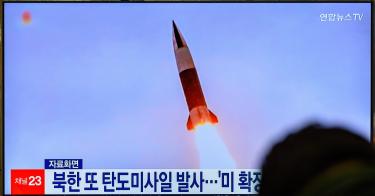The rapidly increasing tempo of North Korean missile tests underscores the importance of a viable homeland missile defense.
On Oct. 3, Pyongyang conducted its 39th ballistic missile test of the year—the eighth since just last week. The most recent shot flew right over Japan and traveled so far that it could have reached the U.S. territory of Guam.
The tests came on the heels of North Korea’s announcement of a new law that more clearly articulates Pyongyang’s policy on the offensive use of nuclear weapons, including preemptive nuclear attacks. The law lowers the threshold for a nuclear strike. It holds that, if the regime perceives any attack on its leadership, nuclear command structure or important strategic targets to be imminent, it has the right to use nuclear weapons preemptively.
North Korea is reportedly preparing its seventh test of a nuclear warhead, now predicted to occur as soon as mid-October. Another nuke test would help North Korea advance its nuclear capabilities, including the maturation of a long-range missile capable of carrying multiple warheads. This is especially worrying given North Korea’s continuing drive to develop a nuclear missile that can reliably strike U.S. soil.
>>> The U.S. Must Strengthen Its Nuclear Forces to Deter Growing Nuclear Threats
Together, the U.S. and South Korea have been making a concerted effort to bolster defense and deterrence of the North Korean regional missile threat, but those improvements do not negate the need for greater investment into missile defense for the U.S. homeland.
The current Ground-based Midcourse Defense (GMD) system of 44 ground-based interceptors located in Alaska and California was initially deployed in 2004 to take these kinds of rogue threats off the table. The system has evolved and improved overtime to keep up with the North Korean threat and mitigate Pyongyang’s attempts at nuclear blackmail.
A homeland missile defense that can outpace the North Korean threat also affords the U.S. greater freedom of action in deterring Kim’s aggressive behavior. For instance, the U.S. can more confidently threaten the deployment of strategic assets, such as bombers or submarines, to the Korean peninsula in the event of a Pyongyang nuclear test with the knowledge that the U.S. homeland is protected.
Homeland missile defense increases in importance even in response to North Korea’s increasingly capable short-range missiles against U.S. allies. With a credible homeland missile defense in place, our South Korean and Japanese allies can be assured that North Korea cannot “decouple” them from the U.S. by threatening the U.S. homeland during a crisis.
The question is: Will U.S. homeland missile defense be able to keep pace with Kim’s accelerated nuclear and missile programs?
We know the regime is developing missiles capable of carrying multiple warheads and improving its ability to deploy more missiles to the field. This could allow Pyongyang to eventually deploy sufficient nuclear warheads and inter-continental ballistic missiles to overwhelm the current Ground-Based Midcourse Defense system.
The Defense Department’s program to improve the system includes extending the service lives of the existing 44 interceptors while building the Next Generation Interceptor, which will add 20 new and modern interceptors to the system. This will increase both the capability and capacity of our missile defenses. But the improvements cannot not stop there. The Pentagon will need to plan for what’s next.
>>> 3 Ways Chinese Nuclear Buildup Threatens U.S. National Security Interests
The Senate Armed Services Committee’s defense policy bill for the upcoming fiscal year wisely included a requirement to fund the purchase of 64 Next Generation Interceptors (NGI), rather than merely 20. In March, testimony by Deputy Undersecretary of Defense Sasha Baker also noted the potential for boosting NGI procurement numbers above 20.
At the same time, the United States should also invest in advanced technologies, like directed energy, to provide for more efficient defense in the future.
Planning for future homeland missile defense improvements should begin now to ensure we stay well ahead of the North Koreans. A RAND Corporation report from 2021, for example, estimated that North Korea could have several dozen long-range missiles and 200 warheads by 2027. We don’t want to get caught flat footed if that happens.
Multiple administrations have worked for years to achieve denuclearization on the Korean peninsula, with little to show for it. Until North Korea finally ends its nuclear program, the United States must continue to make the investments necessary to negate Pyongyang’s Korean nuclear coercion and protect the American people should deterrence ever fail.
This piece originally appeared in The Hill on 10/11/2022, at https://thehill.com/opinion/national-security/3682561-north-korean-provocations-highlight-continuing-need-for-homeland-missile-defense/



